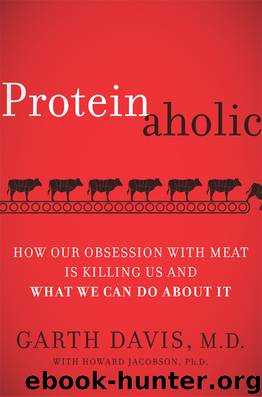Proteinaholic by Garth Davis M.D

Author:Garth Davis, M.D.
Language: eng
Format: epub
Publisher: HarperCollins
Published: 2015-08-17T16:00:00+00:00
Heme Iron and N-Nitroso Compounds
We ingest two types of iron from food: heme iron and nonheme iron. Animal foods are the only sources of heme iron, which is often assumed to be nutritionally superior since we absorb it more efficiently into our bloodstream. Evidence is mounting, however, that links heme iron to various cancers, including colorectal cancer (Qiao and Feng 2013).
We’re not exactly sure how heme iron contributes to cancer, but one promising theory links heme iron consumption to the creation of unstable N-nitroso compounds (NOC) in the body (Bingham, Hughes, et al. 2002). One of the EPIC studies showed that the more NOC produced, the higher the risk of gastrointestinal cancer; rectal cancer, specifically. A 2003 randomized controlled trial found that feeding people meat led to higher levels of NOC in their stool. When they were fed an equivalent amount of vegetable protein, their levels of NOC were much lower. And here’s the fascinating part about this study: supplementation with 8 grams of heme iron spiked NOC levels, while adding ferrous (nonheme) iron had no such effect (Cross, Pollock, et al. 2003). So the “good-for-us” iron from meat may turn out to be the missing ingredient in turning nitrates into cancer-causing NOC.
An interesting 2010 study supports this theory. Researchers fed 14 participants a high-red-meat diet for 8 days, followed by 8 days of a combination of red meat and fish, then 8 days of a high-fish diet. Their stool samples were examined during each phase of the trial. The study found more NOC and heme iron on the red meat diet, and less on the fish diet (Joosen, Lecommandeur, et al. 2010). And another study by the same team found more NOCs and more DNA damage in the group eating red meat and processed meat than in those on a vegetarian diet (Joosen, Kuhnle, et al. 2009).
As with HCAs, eating more plants appears to reduce the effects of heme iron. Beets, for example, are high in nitrates, but there’s no evidence that those chemicals are converting into NOC; beets have fewer amino acids than meat and are chock-full of antioxidants. It appears this may block the conversion of plant sources of nitrates into NOC. The Mediterranean diet consists of many foods with high antioxidant ability and also have the ability to chelate iron; that is, take it out of the bloodstream and remove it from the body (El and Karakaya 2004). Greens in particular are highly protective. This finding may also contribute to explaining the small differences found by EPIC-Oxford between meat eaters and vegetarians. The meat eaters were consuming a fair amount of plant-based food, which may have been partially canceling the toxic effects of heme iron.
Download
This site does not store any files on its server. We only index and link to content provided by other sites. Please contact the content providers to delete copyright contents if any and email us, we'll remove relevant links or contents immediately.
Nutrition for Sport, Exercise, and Health by Spano Marie & Kruskall Laura & Thomas D. Travis(3559)
Nutrition for Sport, Exercise, and Health by Marie Spano & Laura Kruskall & D. Travis Thomas(3554)
The Sprouting Book by Ann Wigmore(3419)
Flavor Flours by Alice Medrich(2649)
Memory Rescue by Daniel G. Amen(2260)
Superfood Smoothie Bowls: Delicious, Satisfying, Protein-Packed Blends that Boost Energy and Burn Fat by Chace Daniella(2239)
Dirty Genes by Ben Lynch(2163)
The Bad Food Bible by Aaron Carroll(2125)
The Poisoner's Handbook by Deborah Blum(1984)
Genius Foods by Max Lugavere(1977)
Good Calories, Bad Calories by Gary Taubes(1957)
The Main Street Vegan Academy Cookbook by Victoria Moran(1942)
The I Quit Sugar Cookbook by Sarah Wilson(1880)
Core Performance Essentials by Mark Verstegen(1862)
Memory Rescue: Supercharge Your Brain, Reverse Memory Loss, and Remember What Matters Most by Amen Dr. Daniel G(1850)
Big Girls Do It Stronger by Jasinda Wilder(1805)
Android App Development by Franceschi Hervé J.;(1735)
Sugar Crush by Dr. Richard Jacoby(1689)
Dr. Colbert's Keto Zone Diet by Don Colbert(1549)
